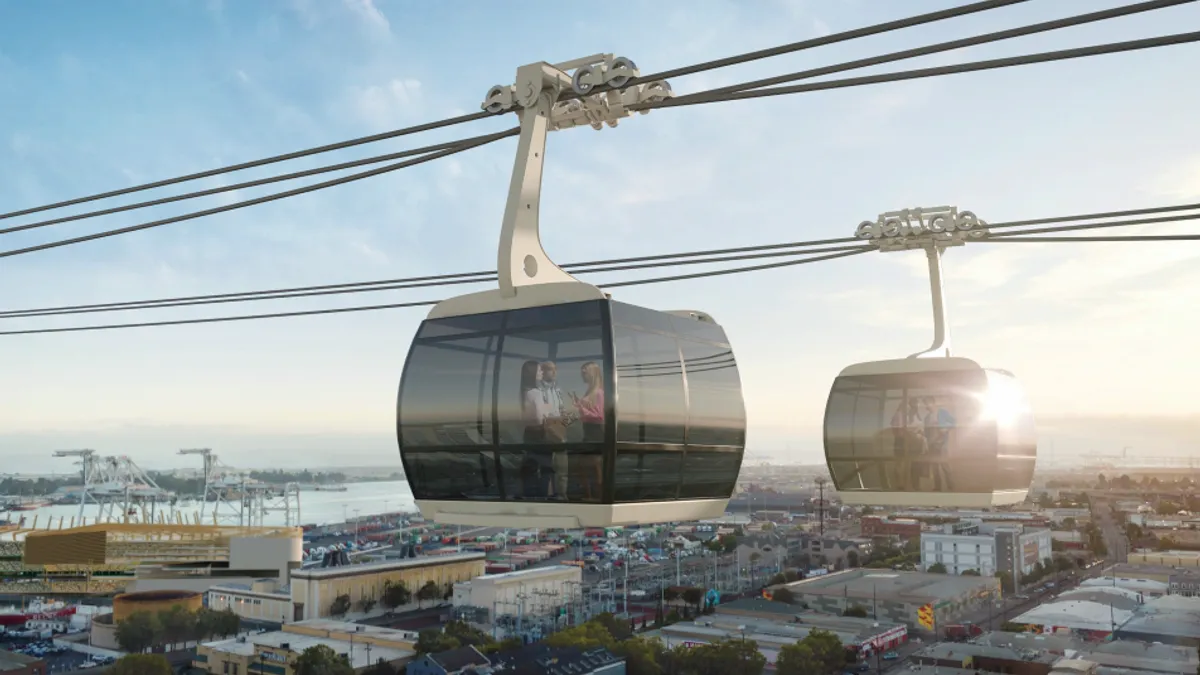Florida's Tampa Bay region is looking sky high for ways to expand its transit network and address traffic congestion, with the City of Clearwater considering two separate aerial transit projects.
Last week, the Clearwater City Council gave its go-ahead for the Tampa Bay Area Regional Transit Authority (TBARTA) and metropolitan planning organization Forward Pinellas to study a gondola system in the city. The concept — backed by St. Petersburg developer Darryl Leclair — is still in its early stages, but planners say it would use a two-mile cable car line to connect downtown Clearwater to the beach, with the potential to expand across the Tampa Bay region into cities including St. Petersburg.
"I think most people are intrigued, they see it as a way to get above the gridlock and congestion in a way that’s safe and clean," said Whit Blanton, executive director of Forward Pinellas. "It also distinguishes the community and would complement the natural beauty and character of the area that already brings people here."
This city council backing comes nine months after the body passed a resolution to support the exploration of a pod-based aerial transit system from BeachTran Clearwater. Using technology from California-based skyTran, BeachTran would zip four-person pods between Clearwater and the beach at up to 100 mph along a maglev track, using a solar-powered system. BeachTran has said the pods could also carry cargo, and that this system could be expanded regionally.
There has been little news about this system since its February approval, however. BeachTran Clearwater Founder Tom Nocera told WFLA Radio in a July interview that the COVID-related shutdown of Clearwater Beach led planners to "rethink" the planning of their project.
In an email, Nocera told Smart Cities Dive that the recent emphasis on sanitation in public transit has "resulted in a branding opportunity we think will help position us as the most sanitary mode of public transit," because of its use of ultraviolet light technology to disinfect passenger vehicles. Beyond this, Nocera said skyTran is not discussing the project.
Adding transit capacity to the sky
Clearwater's home of Pinellas County has a population of nearly one million people, despite being the second-smallest county in Florida by square mile. Many major roadways cross over water and have limited capacity to expand, and there is only one major rail line through town.
Outside of ski resorts, aerial transit systems haven’t emerged as a significant transportation option in the U.S., though a handful of cities have adopted them to move people up steep hills. Some South American cities such as Bogotá and Medellín in Colombia have larger cable car systems connecting high points in the city that can move passengers much faster than the winding, hilly roads.
Daniel Rodriguez, a professor in the department of city and regional planning at the University of California, Berkeley, said cable cars can be an option in congested cities since they require little land to support the system.
“It’s been more of a boutique solution rather than a general transit option, but I think it could become more accepted,” Rodriguez said. “If you look at urban transportation, we’ve broadened the scope of what is acceptable with scooters and shared bikes and shared cars. New modes can become part of that equation.”
Cities have slowly begun opening up to experimental ideas like underground pod systems and flying car fleets, and cable cars are increasingly on the table. In 2018, Los Angeles Metro received a proposal for a gondola to connect Dodger Stadium to the Union Station transit hub, and Pittsburgh Mayor Bill Peduto teased a gondola system earlier this year to connect major neighborhoods in his city.
Officials in Park City, UT have also explored a gondola system to alleviate traffic, though the Park Recorder reported this summer that cost concerns make it unlikely. Meanwhile, Austin, TX rejected a proposal for a 9-mile gondola network, deeming it a “niche” application, not an effective people mover.
Viability and costs
The novelty of an urban gondola may drive its public appeal, but the lack of a well-used system to view as a model may pose a barrier to a Clearwater project.
“It will be great when you’re in it going across the Causeway and there’s bumper to bumper traffic and you’re just kind of looking and waving at all the cars standing still,” said Councilmember Hoyt Hamilton at last week’s hearing. “But on the days when that’s not the situation, it’s more of an attraction than an actual transit system, to me.”
The cable car project is likely to conduct a planning report using funds earmarked by the state legislature to gauge its estimated cost, ridership and impact on traffic. With the support of Leclair, the project has viable financial backing, but still faces potential headwinds. Residents may be concerned about its impact on views and landscaping, while projected interest and ridership will be needed to justify its creation.
The BeachTran project, meanwhile, depends on the viability of the maglev technology, which is being tested in San Antonio, TX. Blanton of Forward Pinellas said he was skeptical about the unproven maglev technology, but ultimately noted that Tampa should make a public investment in a system that everyone can use.
"We have not made a commitment to invest in public transit … and when people experience less than ideal circumstances it forces us to think about an entirely new system," Blanton said. "We know we need to improve transit and this gondola proposal came up with a private individual that can fund it. But if I sound a little ambivalent, it’s because I want to see us invest as a region in transit."



















